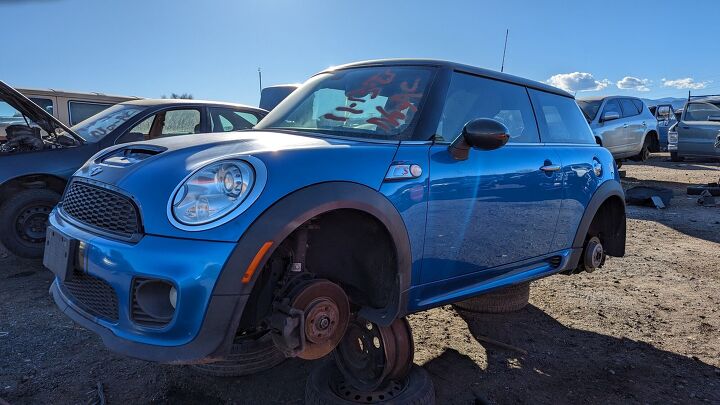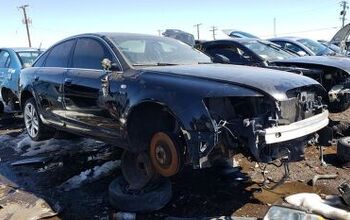Junkyard Find: 2007 Mini Cooper S

The "New Mini" first appeared in North American showrooms as a 2002 model, as part of the turn-of-the-century wave of retro-styled machinery that included the Volkswagen New Beetle, Chrysler PT Cruiser and Chevrolet HHR. It took about a decade for the 21st-century Mini to begin showing up in car graveyards in large numbers, and they remain easy to find today. Here's an '07 Cooper S model in a Colorado yard.
When BMW bought the Rover Group in 1994, the original Mini (which began production by the British Motor Corporation in 1959) was still being built. The various BMC successors had tried and failed repeatedly to design a Mini successor over the decades, but it took a big stack of Deutschmarks (and, later on, Euros) to do the trick.
I know that the official name of this car's marque is spelled MINI in annoying all-caps letters, but I have adopted a policy of repairing make and model names that incorporate such maddening tricks as punctuation marks or all-uppercase/all-lowercase letters. That means I refuse to play the marketers' clever games with the Nissan LEAF, smart fortwo, Volkswagen up! and all the rest (FIAT is a tough one, since it started out as a legitimate acronym for Fabbrica Italiana Automobil di Torino, but the company itself ditched the all-caps spelling many years ago).
The MSRP for the regular 2007 Mini Cooper was $18,050, while the hot-rod Cooper S version listed at $21,850 (those prices come to $27,673 and $33,498 in 2024 dollars).
New for 2007 was this 1.6-liter turbocharged straight-four engine co-developed by Peugeot and BMW, replacing the supercharged Brazilian 1.6 and its Chrysler/Rover ancestry.
This engine was rated at 175 horsepower and 177 pound-feet.
A six-speed manual was standard equipment. A six-speed Steptronic automatic was available; unusually, the buyer of this car chose the three-pedal setup.
There were convertible versions of the Cooper and Cooper S available as well.
Mini dealers offered many add-on accessories, including these John Cooper Works sill plates. They didn't make this car a real JCW, but still looked cool.
Way back in 2009, a 24 Hours of Lemons team tried to get a 2005 Cooper S through the BS Inspection unscathed, earning 1,066 penalty laps in the process.
By about the middle 2010s, these cars began appearing en masse in the boneyards I frequent, so many that I thought about doing a Minipocalypse article on the subject (along the lines of the Subiepocalypse and 240calypse pieces I wrote for this publication).
Now, of course, Mini Coopers are seen competing in most 24 Hours of Lemons races. They're cheap, quick enough to be fun, and junkyard parts are plentiful. Their main drawback is poor reliability, a trait they share with Lemons cars made by Toyota, Audi, Subaru, Mitsubishi and Nissan (strangely, cheap Alfa Romeos are very reliable under punitive road-racing conditions).
You could do a lot worse than a Mini Cooper S as a cheap project car, thanks to their fell-off-a-cliff depreciation and vast parts availability.
There is a lot of room in here, huh?
From the "What could they have been thinking?" department.
2007 Mini Cooper S in Colorado junkyard.
2007 Mini Cooper S in Colorado junkyard.
2007 Mini Cooper S in Colorado junkyard.
2007 Mini Cooper S in Colorado junkyard.
2007 Mini Cooper S in Colorado junkyard.
2007 Mini Cooper S in Colorado junkyard.
2007 Mini Cooper S in Colorado junkyard.
2007 Mini Cooper S in Colorado junkyard.
2007 Mini Cooper S in Colorado junkyard.
2007 Mini Cooper S in Colorado junkyard.
2007 Mini Cooper S in Colorado junkyard.
2007 Mini Cooper S in Colorado junkyard.
2007 Mini Cooper S in Colorado junkyard.
2007 Mini Cooper S in Colorado junkyard.
2007 Mini Cooper S in Colorado junkyard.
2007 Mini Cooper S in Colorado junkyard.
2007 Mini Cooper S in Colorado junkyard.
2007 Mini Cooper S in Colorado junkyard.
2007 Mini Cooper S in Colorado junkyard.
[Images: The Author]
Become a TTAC insider. Get the latest news, features, TTAC takes, and everything else that gets to the truth about cars first by subscribing to our newsletter.

Murilee Martin is the pen name of Phil Greden, a writer who has lived in Minnesota, California, Georgia and (now) Colorado. He has toiled at copywriting, technical writing, junkmail writing, fiction writing and now automotive writing. He has owned many terrible vehicles and some good ones. He spends a great deal of time in self-service junkyards. These days, he writes for publications including Autoweek, Autoblog, Hagerty, The Truth About Cars and Capital One.
More by Murilee Martin
Latest Car Reviews
Read moreLatest Product Reviews
Read moreRecent Comments
- MacTassos Bagpipes. And loud ones at that.Bagpipes for back up warning sounds.Bagpipes for horns.Bagpipes for yellow light warning alert and louder bagpipes for red light warnings.Bagpipes for drowsy driver alerts.Bagpipes for using your phone while driving.Bagpipes for following too close.Bagpipes for drifting out of your lane.Bagpipes for turning without signaling.Bagpipes for warning your lights are off when driving at night.Bagpipes for not coming to a complete stop at a stop sign.Bagpipes for seat belts not buckled.Bagpipes for leaving the iron on when going on vacation. I’ll ne’er make that mistake agin’.
- TheEndlessEnigma I would mandate the elimination of all autonomous driving tech in automobiles. And specifically for GM....sorry....gm....I would mandate On Star be offered as an option only.Not quite the question you asked but.....you asked.
- MaintenanceCosts There's not a lot of meat to this (or to an argument in the opposite direction) without some data comparing the respective frequency of "good" activations that prevent a collision and false alarms. The studies I see show between 25% and 40% reduction in rear-end crashes where AEB is installed, so we have one side of that equation, but there doesn't seem to be much if any data out there on the frequency of false activations, especially false activations that cause a collision.
- Zerocred Automatic emergency braking scared the hell out of me. I was coming up on a line of stopped cars that the Jeep (Grand Cherokee) thought was too fast and it blared out an incredibly loud warbling sound while applying the brakes. I had the car under control and wasn’t in danger of hitting anything. It was one of those ‘wtf just happened’ moments.I like adaptive cruise control, the backup camera and the warning about approaching emergency vehicles. I’m ambivalent about rear cross traffic alert and all the different tones if it thinks I’m too close to anything. I turned off lane keep assist, auto start-stop, emergency backup stop. The Jeep also has automatic parking (parallel and back in), which I’ve never used.
- MaintenanceCosts Mandatory speed limiters.Flame away - I'm well aware this is the most unpopular opinion on the internet - but the overwhelming majority of the driving population has not proven itself even close to capable of managing unlimited vehicles, and it's time to start dealing with it.Three important mitigations have to be in place:(1) They give 10 mph grace on non-limited-access roads and 15-20 on limited-access roads. The goal is not exact compliance but stopping extreme speeding.(2) They work entirely locally, except for downloading speed limit data for large map segments (too large to identify with any precision where the driver is). Neither location nor speed data is ever uploaded.(3) They don't enforce on private property, only on public roadways. Race your track cars to your heart's content.
































































Comments
Join the conversation
German design and British assembly.....two wrongs don't make it right...think I'll pass!!! 🚗🚗🚗
I can comment on these. My wife always thought the Minis were "cute" so I bought her a used 2005 (non-S, 5 speed) for one of her "special" birthdays. She loved it and I kinda did too. Somehow a hole developed in the transmission case and the fluid drained out, ruining the car (too expensive to fix). A local mechanic bought it for $800.
We then bought a used 2015 S (6 speed) which we still have today (80k miles). Her sister just bought a used S as well (also manual). It has been a dependable car but BMW-priced maintenance and premium gas hurts for sure. I think the earlier generation (like in the article) were better looking with cleaner lines. The 2015 S rides too stiff for me (Chicago roads) but is a hoot on smooth ones. It does seem to shift weird - its hard to describe but it shifts differently from every other manual I have driven. No matter how hard I try, so won't let go of her Mini.